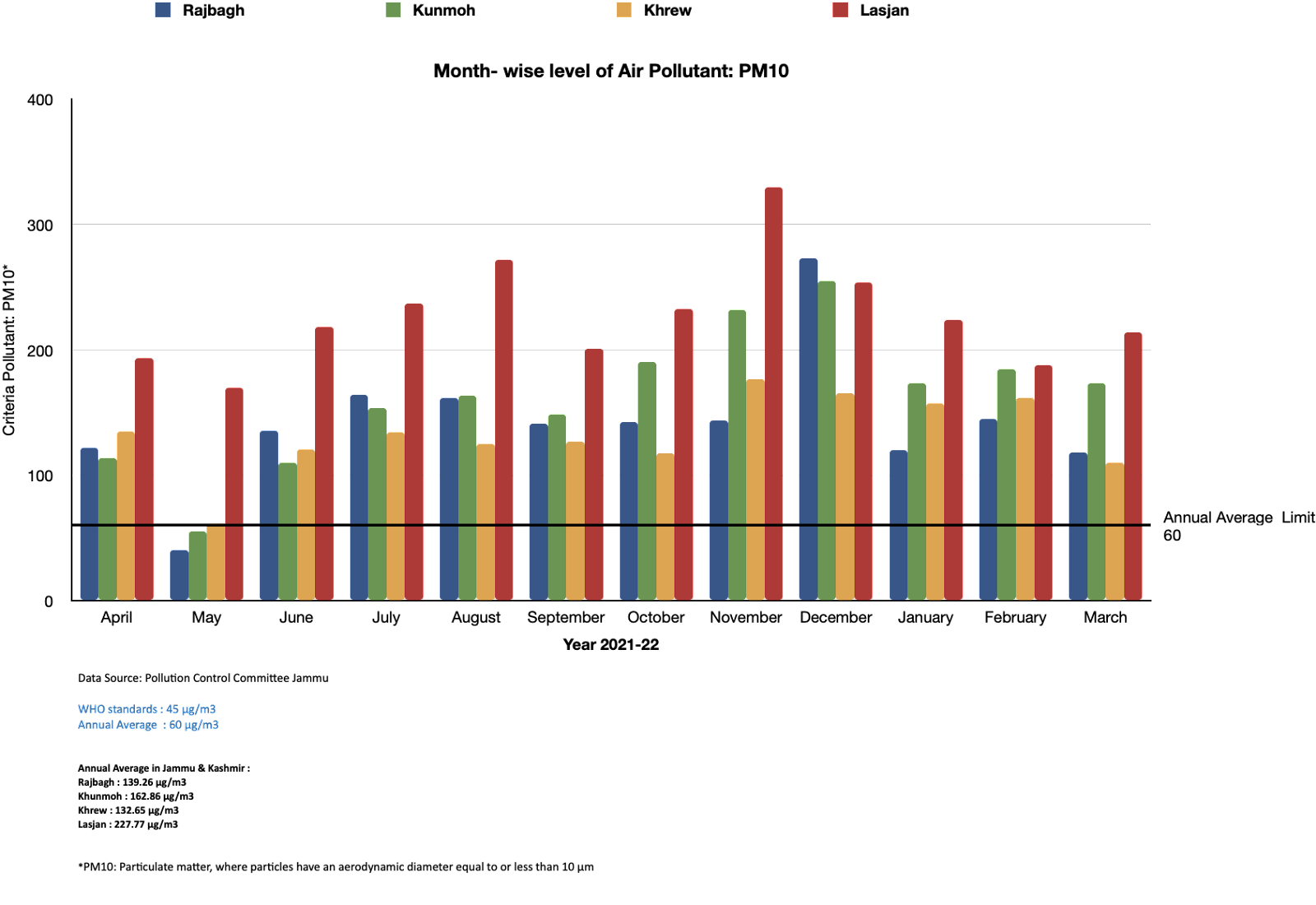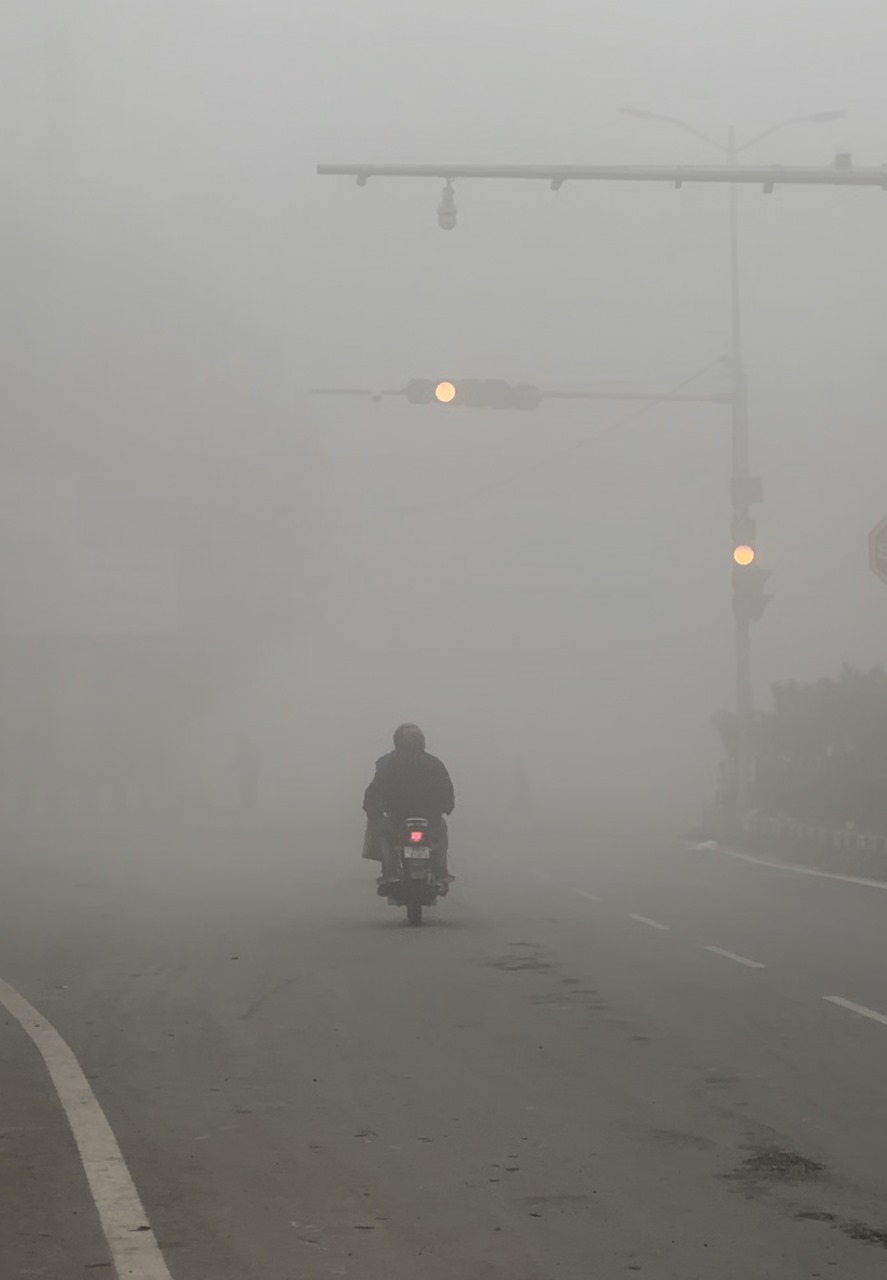Introduction
Nestled between the mighty Himalayas, Kashmir is often celebrated as the “Paradise on Earth”, with its pristine water bodies, snow-capped mountains, lush green meadows, and clean air. Yet beneath the breathtaking landscapes and grandeur of beauty, it has not escaped the impacts of climate change: receding glaciers, changing weather patterns, and rising temperatures are a few among many other environmental challenges that are affecting the region.
The threat of air pollution persists beneath the calm and peaceful facade of Kashmir’s natural beauty and poses a significant danger to both the ecological stability of the region and the health of its citizens. While the region’s scenic beauty remains unparalleled, in recent years, Kashmir has been subjected to various sources of air pollution, including industrial emissions, vehicular pollution, biomass burning, and dust from construction. There is a pressing need for air quality monitoring in Jammu and Kashmir (J&K) due to its unique geographical and environmental factors. This piece sheds light on the need for comprehensive air monitoring infrastructure in the Kashmir Valley.
Data Deficiency and Monitoring of Air Quality
Monitoring air quality is the first step in understanding the problem of air pollution. It lays the groundwork for approaching the problem. Data generation and dissemination over long periods of time provide valuable insights, which aid in formulating effective pollution management policies. Secondly, the availability of air quality data to the public is an essential step towards enabling people to take preventive measures to protect themselves from the harmful effects of air pollution.
Currently in Kashmir, there is a lack of comprehensive air quality monitoring systems . As per the information available, in terms of monitoring mechanisms, there is only one Continuous Ambient Air Quality Monitoring System (CAAQMS) in Srinagar City installed under the National Clean Air Programme (NCAP) and three manual monitoring stations installed under the National Air Quality Monitoring Programme (NAMP) at Khrew, Khunmoh, and Lasjan. The Revised Action Plan of Srinagar City under the National Clean Air Program states that there currently are five permanent Ambient Air Quality Monitoring Stations to monitor PM2.5 located at Rajbagh, Hyderpora, Boulevard near Dalgate, Jahangir Chowk and Soura near SKIMS.
Further, the existing monitoring systems in the Kashmir region are predominantly installed in the industrial belts, aimed at tracking pollution levels from cement factories. However, apart from industries, air pollution in the region also stems from vehicular emissions and construction activities. Unfortunately, due to the disproportionate distribution of monitoring systems, the pollution levels in the towns are not being accurately captured, posing a significant challenge in identifying the extent of the problem. Since pollution is alarmingly high in the existing areas where the monitoring stations have already been placed, what Kashmir needs is a robust monitoring system for tracking the trends of deteriorating air quality within the region. This data deficiency hinders the accurate assessment of air quality, making it difficult to implement air quality improvement measures in the first place.
What does the Air Quality data in Kashmir suggest?
The existing data available from the Pollution Control Board for the year 2021-22 suggests that the annual average of the pollutants in Jammu and Kashmir is above the average limit of the National Ambient Air Quality Standards (NAAQS), i.e 60 µg/m3. Data analysis available from the monitoring stations reveals the levels of air pollution have been significantly high in the Khrew and Lasjan areas of district Pulwama and Khunmoh of district Srinagar.
The national average of maximum standards for criteria pollutant PM10 is set at 60 µg/m3 (annually). The available data on air quality in Kashmir province is from four locations, ranging from 201 to 300 µg/m3 which falls under the poor category, potentially causing breathing discomfort to a healthy human on prolonged exposure. At the same time, the annual average of PM10 at Rajbagh, Srinagar (which is a non-attainment city under the National Clean Air Programme), remains at 132 µg/m3. The annual average of the PM10 pollutant at Khrew, Khunmoh, and Lasjan was recorded at 132.65 µg/m3, 162.86 µg/m3, and 277.77µg/m3 respectively.
What would make the situation worse is that as the winter season approaches, most of the heating needs are fulfilled by burning biomass and coal, which leads to the rampant spread of outdoor and indoor pollutants. This can make breathing difficult and exacerbate existing respiratory problems. It is alarming that the quality of air is not poor only during the winter but even during the summer season when the air quality is slightly better, the level of PM10 pollutants still remains above 200 µg/m3 in the industrial area of Lasjan. The available data demonstrates how the ambient air quality standards exceed the maximum set standards.
Graph depicting the month-wise level of PM10 for the year 2021–22 in Kashmir Province

What do the guidelines say?
The National Air Monitoring Programme (NAMP), executed by the Central Pollution Control Board (CPCB), mainly identifies four criteria pollutants for routine monitoring at various locations, which are: sulfur dioxide (SO2), nitrogen oxides (NO), respirable suspended particulate matter (RSPM/PM10), and fine particulate matter (PM2.5). The National Air Quality Index, compiled by the Ministry of Environment, Forest and Climate Change (MoEFCC), is considered a yardstick for measuring air quality by computing the indices of eight criteria pollutants ranging from 0 to 500. The higher the Air Quality Index (AQI) value, the greater the level of air pollution and the greater the impact on the health of human beings.
According to the Action Plan of Srinagar City under NCAP, vehicular emissions are cited as the primary cause of high levels of criterion pollutants in Srinagar, followed by dust from road construction activities, such as widening roads and constructing flyovers. The Action Plan also highlights that Srinagar City experienced the highest levels of air pollution from November to January. As per the news reports, the District Level Implementation Committee on NCAP convened in May, 2023 finalized an amount of Rs 33 crore under the Action Plan within the Srinagar City.
Mitigation of Air pollution is a complex problem that necessitates the collaboration of various stakeholders. The government has taken several measures in compliance with the action plan to address the issue of air quality within the stipulated time frame by relevant implementation agencies such as the transport department, traffic police, pollution control committee (JKPCB), municipal corporations, department of floriculture, Srinagar Development Authority, department of industry and commerce, department of environment, ecology and remote sensing, department of health, Department of Consumer Affairs and Public Distribution.
The gist of activities with each separate intervention for improving the air quality index in Srinagar City:
| List of Activities | Amount envisaged to be spent (in Rs) |
| Creation of Green Zones: mass plantation across the city with central verges | 10.00 crore |
| Vertical Plantation at various locations including flyovers | 5 crore |
| Landscaping/ development of lawns, walking spaces plantations near hospitals (GMC and SKIMS) | 2.5 crore |
| Earthen shoulders along urban roads | 4 crore |
| Mission Life | 2 crore |
| Management of Horticultural waste | 1 crore |
| Construction of water fountains | 2.5 crore |
| Information, Education and Communication (IEC) activities | 2.5 crore |
However, it is important to point out the implementation phase of the plan and the total amount of money spent on each activity so far is unclear. Additionally, we are uncertain about which subsequent actions have been appropriately executed within the given timeframe.
Furthermore, it should be noted that the Action Plan, which was funded with a specific amount under NCAP only applies to the city of Srinagar and no other districts. The valid question here is does this mean that there is no pollution in other districts? Or is it possible that we are simply unaware of the levels of pollutants in other districts due to a lack of monitoring stations?
Conclusion
In light of the above stated so far, considering the multifaceted and disproportionate impact of climate change and ongoing environmental crises, it is crucial to conduct a thorough data study and analysis to identify the sources and magnitudes of pollution within specific geographical regions in Kashmir. Given how serious and urgent the issue of clean air is, it is high time that we have comprehensive data monitoring structures installed in each district for robust monitoring of criteria pollutants in order to devise appropriate interventions to mitigate the levels of rising pollution in the Kashmir province. Furthermore, to meet the time-bound national target of reducing the concentration of particulate matter by 40% by 2026, compliance with the National Clean Air Programme in Srinagar City is also critical to addressing air pollution through policy actions in transport, agriculture, energy emissions, and urban planning.
References
https://cpcb.nic.in/National-Air-Quality-Index/
https://cpcb.nic.in/Actionplan/Srinagar.pdf
https://app.cpcbccr.com/AQI_India/
https://www.dailyexcelsior.com/air-quality-monitoring-stations/
https://scroll.in/article/1041090/in-srinagar-air-pollution-is-endangering-lives
https://www.greaterkashmir.com/srinagar/action-plan-of-rs-33-cr-under-ncap-finalised-in-srinagar/





Leave a Reply
You must belogged in to post a comment.